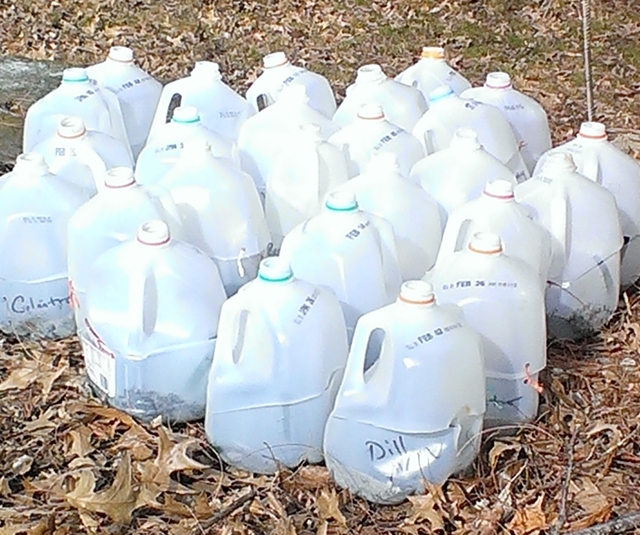Winter Sow your Vegetable Seeds!
First off, if you are unfamiliar with the basics of winter sowing, you may want to start with the Winter Sowing 101 article, then come back for the vegetable sowing specifics.
First, if you want to see a 10 minute video on what winter sowing is and how it works, click here.
The only vegetable seeds I don't winter sow are root crops; radishes, carrots, parsnips and the like which don't care to be transplanted and the act of transplanting them could damage their fragile roots. I have found there is no benefit to winter sowing root crops.
The Vegetables I Winter Sow

Cucumbers Winter Sown and ready for transplant
The Vegetables I Winter Sow

Cucumbers Winter Sown and ready for transplant
Which vegetables do I winter sow?
All of my herbs, all of my salad greens, all cucurbits like cucumbers, squash, pumpkins, small peppers and cherry tomatoes. The larger varieties of peppers and tomatoes still need to be sown indoors early here in Zone 6 to provide a good harvest. I have also successfully winter sown onions, cabbage, broccoli and the like.
Advantages to winter sowing vegetable seeds:
Winter Sown vegetable seeds will germinate when the time is right. Whereas if I miss the direct sowing date for a vegetable, depending on the plant, I could miss an entire season's harvest.
No Wasted Space
Maybe there are some gardeners with tons of garden space, but if space is limited you can take full advantage of the space that you do have. If you've ever had spotty germination when direct sowing, that's frustrating. Also frustrating is direct sown seeds that have rotted from excessive rains or dried out from lack of water.
With winter sowing, your seeds are in their protected little "greenhouse" until they are ready to be transplanted into their final space, whether that be in the garden, raised bed or containers. No empty spots! No thinning overcrowded seedlings. Just healthy, strong seedlings to produce a good harvest.
The Spring Marathon
For most gardeners, Spring is the busiest time in the garden. I don't know about you, but here at Sunset Hosta Farm, my springs are ridiculously busy. Any gardening job that I can do in the winter frees up that many hours in the spring later.
If I get super busy at the beginning of the spring, I can simply cut off the top of the winter sowing container and let the seedlings continue to grow until I have time to transplant.
And if the weather suddenly has an unexpected cold spell, the seedlings are fine to wait it out in their protected home.
Beat the Winter Blues
Here in Ohio, our winters can be brutal and feel they'll go on forever and the green of the garden begins to feel like a fading memory.
Winter Sowing gives me the chance to put my hands in the soil, a chance to remind myself that Spring will come. And when it does, a lot of the work has already been done in time for the Spring onslaught.
~~~~~~~~~~
So those are some great reasons to winter sow your vegetables. It's one of the easiest ways to start a vegetable garden!
Have You Tried Winter Sowing??
If you haven't tried winter sowing, you're in for a treat. This method is especially good for sowing herbs. Winter sowing is basically sowing seeds in the bottom of milk jugs in the winter, setting the milk jugs outside for the winter and leaving them there until the seeds germinate in the Spring.
For our article containing detailed information about Winter Sowing, click here.
To watch our 30 minute video on how to winter sow, click here.
~~~~~~~~~~




.png)






No comments:
Post a Comment
Note: Only a member of this blog may post a comment.